Nritta Hastas. The Decorative Gestures of Hands
These hastas are used only in Nritta or pure dance. The great Bharata mentions
30 hastas in his Natyashastra. Kuchipudi uses them all.
SHLOKA:
CHATURASRO TATHO DRUTTOU
TATHEI TALYAMUKHOU SMRUTOU
SWASTIKO VIPRAKIRNAMCHA
ARALAKATAKAMUKHOU
AVIDDHAVAKROU SUCHASYOU
RECHITA VARDHARECHITOU
UTTANAVANCHITOUCHEYVA
PALLAVOUCHA TATHA KAROU
NITAMBAVATI VIGNEYOU
KESHABADHU TATHAIVACHA
LATAKYAICHA TATHA PRAKTOU
KARIHASTU TATHAIVACHA
PAKSHAVANCHITAKOUCHEIVA
PAKSHOPRADYOTAKOU TATHA
GNEYAYU GARUDAPAKSHOUCHA
DANDAPAKSHOU TATHEIVACHA
URDHVAMANDALINOU CHEIVA
PARSHVAMANDALINOI TATHA
UROMANDALINOU CHEIVA
URAHPARSHVADHAMANDALE
MUSHTIKASWASTIKOCHAPI
NALINIPADMAKOSHAKO
ALLAPALLAVALBANEICHA
LALITO VALITO TATHA
1. CHATURASRA
 VAKSHASTHOSHTANGULASTHOU VAKSHASTHOSHTANGULASTHOU
TU PRANGMUKOU KATAKAMUKHOU
SAMANA KURPARAMSOU TU
CHATURASTROU PRAKIRTITOU
Meaning: When elbows are held in line with shoulders and hands in the
Katakamukha position are stretched out in front of the chest with the palms
facing away from the body, this is the Chaturasra hasta.
2. UDVRTTA
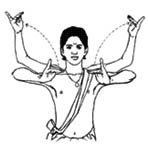 HAMSAPAKSHAKURTOU
HASTOU HAMSAPAKSHAKURTOU
HASTOU
VYAVRUTOU TALAVRUNTAVAT
UDHVRUTHAVITI VIGNEYAVATHAVA
TALAVRUNTAKOU
Meaning: If at first both hands in the Hamsapaksha position are in front of the
chest and then each hand moves up and down to its original position alternately
thus resembling the swaying movement of a palm leaf in the wind, this is the
Udvrtta hasta.
3. TALAMUKHA
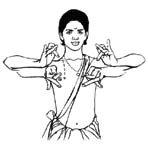 CHATURASRA
STHITOU HASTOU CHATURASRA
STHITOU HASTOU
HAMSAPAKAKSHAKRUTOU TATHA
TIRYAKSTHITOU CHABHIMUKOU
GNEYOU TALAMUKA VITI
Meaning: This hand gesture is similar to the Chaturasra hasta. The only
difference is that the palms of two hands in the Katakamukha position must face
each other. Then it is the Talamukha hasta.
4. SWASTIKA
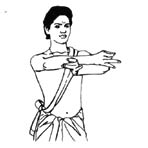 TAVEVA
MANIBANDHANTE TAVEVA
MANIBANDHANTE
SWASTIKAKRUTI SANCHITOU
Meaning: When the hands in the Talamukha hasta are crossed at wrists, this
gesture becomes the Swastika hasta.
5. VIPRAKIRNA
 SWASTIKAVITI
VIKYATOU SWASTIKAVITI
VIKYATOU
VICHYUTOU VIPRAKIRNAKOU
Meaning: When the Swastika hasta turns into the Talamukha hasta, it becomes the
Viprakirna hasta.
6. ARALA KATAKAMUKHA
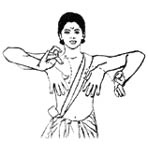 ALAPALLAVASAMSTHANAVURDHV ALAPALLAVASAMSTHANAVURDHV
ASYOU PADMAKOSHAKOU
ARALA KATAKAYOU VA ARALA
KATAKAMUKOU
Meaning: If palms of two hands are turned upwards from the Allapallava (Alapadma)
position and through the Padmakosha position and the right hand transforms into
the Katakamukha hasta and the left hand transforms into the Arala hasta, then
this is the Arala Katakamukha hasta.
7. AVIDDHAVAKRA
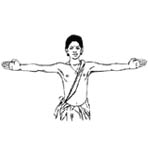 BHUJAMSAKURPARAGRAISTU BHUJAMSAKURPARAGRAISTU
KUTILAVARTITOU KAROU
PARANGMUKHATAYAVIDDHOU
GNEYAVAVIDDHA VAKRAKOU
Meaning: When two hands with palms downwards are in the Pataka position,
shoulders, elbows and hands are in one level, then hands make graceful movements
(palms are raised a little and turned forward and again downwards), then this is
the Aviddhavakra hasta.
8. SUCHIMUKHA
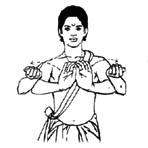 HASTOU
TU SARPASIRASOU HASTOU
TU SARPASIRASOU
MADHYAMANGUSHTAKOU YADA
TIRYAKPRASARITASYOU CHA TADA
SUCHIIMUKOU SMRUTOU
Meaning: When two hands are in the Sarpasirsha position with the thumbs and
middle fingers touching each other, then hands draw a circle and now little
fingers of both hands in the Saprasirsha position touch each other, this is the
Suchimukha hasta.
9. RECHITA
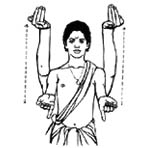 RECHITOU
VAPI VIGNEYOU RECHITOU
VAPI VIGNEYOU
HAMSAPAKSHODDHRUTA BHRAMOU
PRASARITOTTAKATALOU
RECHITAVEVA SANSTHITOU
Meaning: If two hands in the Hamsapaksha position move alternately up and down
with palms looking upwards, this is the Rechita hasta.
10. ARDHARECHITA
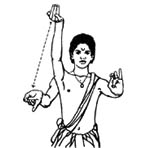 CHATURASRO
BHAVEDVAMAHA CHATURASRO
BHAVEDVAMAHA
SAVYAHASTASCHA RECHITAHA
VIGNEYOU NRUTTATATVAGNAI
RARDHARECHITA SANGNAKOU
Meaning: If the left hand is in the Chaturasra position and the right hand is in
the Rechita position, this is the Ardharechita hasta.
11. UTTANAVANCHITA
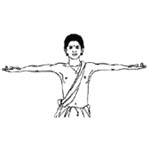 ANCHITOU
KURPARAMSOU TU ANCHITOU
KURPARAMSOU TU
TRIPATAKA KAROU
KINCHITTIRYAGGATAVETOU
SMRUTA VUTTANA VANCHITOU
Meaning: If two hands in the Tripataka position are slightly bent in elbows, and
shoulders and elbows move gently up and down in swaying movements, this is the
Uttanavanchita hasta.
12. PALLAVA
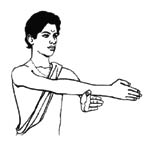 MANIBANDHANMUKTOU
TU MANIBANDHANMUKTOU
TU
PATAKOU PALLAVOU SMRUTOU
Meaning: If two hands in the Pataka position are held in front of the chest and
crossed at wrists, this is the Pallava hasta.
13. NITAMBA
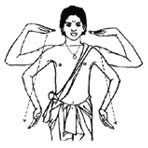 BAHUSIRSHADVINISHKRANTOU BAHUSIRSHADVINISHKRANTOU
NITAMBAVITI KIRTITOU
Meaning: When two hands in the Pataka position move from shoulders to hips, this
is the Nitamba hasta.
14. KESHABANDHU
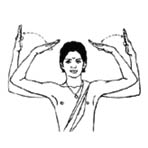 KESHADESADVINISHKRANTOU KESHADESADVINISHKRANTOU
PARIPARSHVA STHITOU YADA
VIGNEYOU KESHABANDHAKYOU
KARAVACHARYA SAMMATOU
Meaning: If hands are in the Pataka position and move constantly top-down from
the top of the head to be found on both sides of face, this is the Keshabandhu
hasta.
15. LATA
 TIRYAKPRASARITOU
CHEIVA TIRYAKPRASARITOU
CHEIVA
PARSHVASAMSTHOU TATHEIVACHA
LATAKYOUCHA KAROU GNEYOU
NUTTABHINAYANAM PRATI
Meaning: If two hands in the Pataka position are stretched sideways and elbows
are in line with shoulders, this is the Lata hasta.
16. KARIHASTA
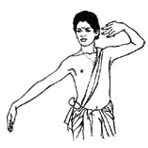 SAMMUNNATO
LATAHASTAHA SAMMUNNATO
LATAHASTAHA
PARSHVATPARSHVAM VILOLITAHA
TRIPATAKOPARAHA KARNE
KARIHASTOU PRAKIRTITOU
Meaning: When the left hand is held near the ear in the Tripataka position and
the right hand is stretched out in the Pataka position and moves from side to
side, this is the Karihasta hasta. The similar movement should be done in the
reverse order i.e. with the right hand held near the ear.
17. PAKSHAVANCHITAKA
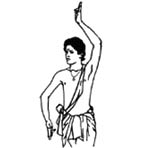 KATISIRSHANIVISHTAGROU KATISIRSHANIVISHTAGROU
TRIPATAKOU YADA KAROU
PAKSHAVANCHITAKOU HASTOU
TADA GNEYOU PRAYOKTRUBIHI
Meaning: If the right hand in the Tripataka position is about six inches away
from the waist with the palm facing the floor and the left hand is six inches
above the head with the palm turned to the right, this is the Pakshavanchitaka
hasta.
18. PAKSHAPRADHOTAKA
 TAVEVA
TU PARAVRUTOU TAVEVA
TU PARAVRUTOU
PAKSHAPRADHYOTAKOU SMRUTOU
Meaning: When hands in the Pakshavanchita position are reversed i.e. the right
hand is above the head and the left hand is near the waist, this is the
Pakshapradhotaka hasta.
19. GARUDAPAKSHA
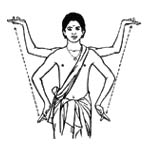 ADHOMUKA
TALAVIDHDOU ADHOMUKA
TALAVIDHDOU
GNEYOU GARUDA PAKSHAKOU
Meaning: If both hands in the Tripataka position are placed on both sides of the
body with the palms facing the hips and then they are lifted up and positioned
at least a foot away from either side of the head with the palms facing up, this
is the Garudapaksha hasta.
20. DANDAPAKSHA
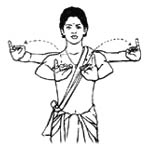 HAMSAPASHARUTOU
HASTOU HAMSAPASHARUTOU
HASTOU
VYAVRUTA PARIVARTITOU
YATHA PRASARITA BHUJOU
DANDAPAKSHAVITI SMRUTOU
Meaning: If both hands in the Hamsapaksha position in front of the chest are
moved alternately sideways until each hand is one level with shoulder, this is
the Dandapaksha hasta.
21. URDHVAMANDALI
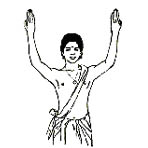 VURDHVAMANDALINOU
HASTA VURDHVAMANDALINOU
HASTA
VURDHVADESA VIVARTANAT
Meaning: When two hands in the Pataka position are fully extended upwards with
the palms facing each other and fingers pointing towards the sky, this is the
Urdhvamandali hasta.
22. PARSHVAMANDALI
 TAVEVA
PARSHVA VINYASTOU TAVEVA
PARSHVA VINYASTOU
PARSHVAMANDALINOU SMRUTOU
VUDVESHTITO BHAVEDEKO
DVITYASCHA VISESHTITAHA
Meaning: When two hands in the Pataka position are stretched out sideways with
the palms facing each other, this is the Parshvamandali hasta.
23. UROMANDALI
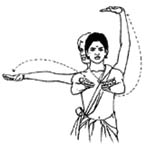 BHRAMITAVURASAHA
STHANE BHRAMITAVURASAHA
STHANE
HYURO MANDALINOU SMRUTOU
Meaning: If two hands in the Pataka position are held in front of the chest with
palms facing up and then the palms with stretched fingers are lifted up and make
circular motions so that the left hand is above the head with fingers facing up
and the right hand with the palm facing down and fingers pointing to the right
is stretched sideways simultaneously with the left hand, this is the Uromandali
hasta.
24. URAHPARSHVADHAMANDALI
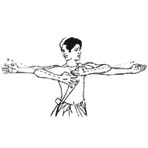 ALAPALLAVAKARALA
VURODHVA ALAPALLAVAKARALA
VURODHVA
BHRAMANA KRAMAT
PARSHVARTASCHA VIGNEYAVURAHA
PARSHVARDVAMANDALOU
Meaning: If at first both hands are held close to the chest, the right hand
being in the Alapallava position and the left hand in the Arala position being
stretched out to the left as much as possible and then both hands start moving
simultaneously from side to side, this is the Urahparshvadhamandali hasta.
25. MUSHTIKASWASTIKA
 HASTOU
TU MANIBANDHANTE HASTOU
TU MANIBANDHANTE
KUNCHITAVANCHITOU YADYA
KATAKAKYOU TU TOU SYATAM
MUSHTIKASWASTIKOU TADA
Meaning: If at first both hands are held close to each other in the Arala
position with fingers facing down and palms facing the body so that elbows are
in one level with shoulders and then hands are lifted slightly, palms are turned
upwards and hands move first into the Allapallava position (Alapadma) and then
into the Katakamukha position and after that they cross at wrists on the waist
level, this is the Mushtikaswastika hasta.
26. NALINIPADMAKOSHA
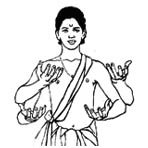 PADMAKOSOU
YADYA HASTOU PADMAKOSOU
YADYA HASTOU
VYAVARTAPARIVARTITOU
NALINI PADMAKOSOU TU TADA
GNEYOU PRAYOKTRUBIHI
Meaning: When two hands in the Padmakosha position move in front of the chest up
and down with fingers running, this is the Nalinipadmakosha hasta.
27. ALAPALLAVA
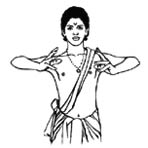 KARAVUDVESHTITAGROU
TU KARAVUDVESHTITAGROU
TU
PRAVIDHAYALAPALLAVOU
Meaning: If two hands in the Pataka position in front of the chest with palms
facing down move upwards with fingers running delicately so that they rise to
the shoulders level and palms start face each other, this is the Alapallava
hasta.
28. ULBANA
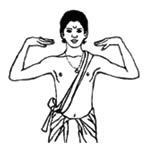 VURDHVAPRASRARITA
VIDHOU VURDHVAPRASRARITA
VIDHOU
VIGNEYA VULBANAVITI
Meaning: If hands in the Alapallava position shift from the
in-front-of-the-chest position into the at-shoulders position and transform into
the Pataka position, this is the Ulbana hasta.
29. LALITA
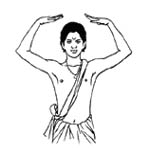 PALLAVOU
CHA SIRODESE PALLAVOU
CHA SIRODESE
SAMPRAPTOU LALITOU SMRUTOU
Meaning: When both hands move from the Ulbana position to the top of the head,
this is the Lalita hasta.
30. VALITA
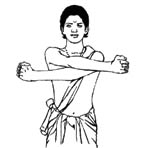 KURPARA
SWASTIKAGATOU KURPARA
SWASTIKAGATOU
LATAKYOU VALITAVITI
Meaning: When both hands in the Pataka position are crossed on the chest level
in elbows, this is the Valita hasta.
| 